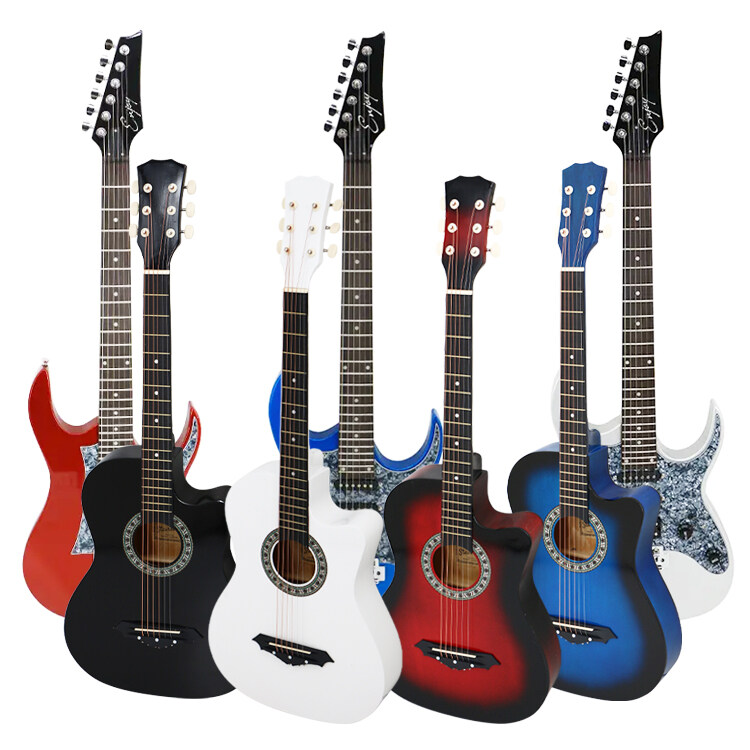Currency



Electric guitars have been around for over 80 years and have become an essential instrument in modern music. The first electric guitar was invented in the 1930s by George Beauchamp and Adolph Rickenbacker. It was called the "Frying Pan" and had a metal body and a single coil pickup. This design was later improved upon by Les Paul and Leo Fender, who created the solid-body electric guitar and the first mass-produced electric guitar, respectively.
Over the years, electric guitars have evolved to include a wide range of styles and features. Today, there are many different types of electric guitars, including solid-body, semi-hollow-body, and hollow-body guitars. They come in a variety of shapes and sizes and can be made from a variety of materials, including wood, metal, and plastic.
The Basic Construction and Working Principles of Electric Guitars
Electric guitars consist of several key components, including the body, neck, fretboard, pickups, and electronics. The body is typically made from wood and is designed to resonate and amplify the sound of the strings. The neck is attached to the body and is usually made from wood as well. The fretboard is attached to the neck and is where the player presses down on the strings to produce different notes.
The pickups are the most important part of an electric guitar. They are responsible for converting the vibrations of the strings into an electrical signal that can be amplified and heard through speakers. There are two main types of pickups: single-coil and humbuckers. Single-coil pickups are known for their bright, clear sound, while humbuckers are known for their warm, fat sound.
The electronics of an electric guitar include the volume and tone controls, as well as any additional effects pedals or processors that the player may use.
How to Choose the Right Electric Guitar
Choosing the right electric guitar can be a daunting task, especially for beginners. There are many factors to consider, including the style of music you want to play, your budget, and your personal preferences.
One of the most important things to consider when choosing an electric guitar is the type of pickups it has. Single-coil pickups are ideal for playing clean, bright tones, while humbuckers are better for playing heavy, distorted tones.
Another important factor to consider is the type of wood used in the construction of the guitar. Different types of wood can produce different tones, so it’s important to choose a guitar that has the right type of wood for the sound you want to achieve.
How to Adjust the Tone and Volume of an Electric Guitar
Adjusting the tone and volume of an electric guitar is relatively simple. Most electric guitars have a volume knob and a tone knob that can be adjusted to change the sound of the guitar. Turning the volume knob up will make the guitar louder, while turning it down will make it quieter. Turning the tone knob up will make the guitar sound brighter, while turning it down will make it sound darker.
Electric Guitar Maintenance and Care
Proper maintenance and care are essential for keeping an electric guitar in good condition. This includes keeping the guitar clean and free of dust and debris, as well as regularly changing the strings and checking the tuning.
It’s also important to store the guitar in a safe and dry place, away from extreme temperatures and humidity. Regularly inspecting the guitar for any signs of damage or wear and tear is also important, as this can help prevent more serious problems from developing.
Using Effects Pedals and Amplifiers to Enhance the Sound of an Electric Guitar
Effects pedals and amplifiers can be used to enhance the sound of an electric guitar. Effects pedals can be used to add distortion, delay, reverb, and other effects to the guitar’s sound, while amplifiers can be used to amplify and shape the sound of the guitar.
Electric Guitar Playing Techniques and Practise Methods
There are many different techniques and practise methods that can be used to improve your electric guitar playing. These include practising scales and chords, learning new songs and solos, and experimenting with different playing styles and techniques.
Recording Electric Guitars in the Studio
Recording electric guitars in the studio requires a different approach than recording acoustic guitars. It’s important to choose the right microphone and amplifier settings to capture the sound of the guitar accurately and to use effects pedals and processors to enhance the sound as needed. It’s also important to pay attention to the placement of the microphone and the acoustics of the recording space to ensure the best possible sound quality.
Email cannot be empty
Password cannot be empty
Email format error
Email cannot be empty
Email already exists
6-20 characters(letters plus numbers only)
The password is inconsistent
Email format error
Email cannot be empty
Email does not exist
6-20 characters(letters plus numbers only)
The password is inconsistent